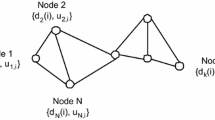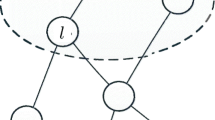Abstract
In this paper, we propose a novel convex combination algorithm based on the distributed diffusion strategy, utilizing the least mean square (LMS) approach to enhance the performance of sensor networks. By enabling communication among nodes, the algorithm achieves decentralization and improves the robustness of the network. To address the limitations of slow convergence speed and large static error associated with fixed step size errors, we introduce a convex combination strategy that integrates two filters with variable step sizes. The LMS algorithm with the convex combination variable step size assigns a higher weight to the filter with a larger step size when the error is significant, ensuring rapid convergence. Conversely, the convex combination small step size filter is assigned a higher weight when the error is small, reducing the error in the stable state. The convergence behavior of the proposed algorithm is analyzed through theoretical analysis, and its complexity is compared with that of the distributed diffusion LMS algorithm through extensive experimental simulations. The results demonstrate that the combination of the LMS algorithm with the distributed diffusion strategy offers advantages in challenging external environments, including improved convergence speed and reduced stability error. This study makes significant contributions to the existing research field by introducing a novel convex combination algorithm that addresses the shortcomings of fixed step size errors and expands the range of available algorithms. By leveraging the distributed diffusion strategy, our approach enhances the robustness of sensor networks and achieves improved performance. The findings of this study provide valuable insights for researchers working on decentralized algorithms and highlight the potential of combining the LMS algorithm with the distributed diffusion strategy in challenging environmental conditions.















Similar content being viewed by others
References
J. Arenas-Garcia, A. Figueiras-Vidal, Adaptive combination of normalised filters for robust system identification. Electron. Lett. 41(15), 874–875 (2005)
J. Arenas-García, M. Martínez-Ramón, A. Navia-Vazquez, A.R. Figueiras-Vidal, Plant identification via adaptive combination of transversal filters. Signal Process. 86(9), 2430–2438 (2006)
S. Ashkezari-Toussi, H. Sadoghi-Yazdi, Robust diffusion LMS over adaptive networks. Signal Process. 158, 201–209 (2019)
A. Carini, G.L. Sicuranza, Fourier nonlinear filters. Signal Process. 94, 183–194 (2014)
A. Carini, G.L. Sicuranza, Recursive even mirror Fourier nonlinear filters and simplified structures. IEEE Trans. Signal Process. 62(24), 6534–6544 (2014)
A. Carini, G.L. Sicuranza, BIBO-stable recursive functional link polynomial filters. IEEE Trans. Signal Process. 65(6), 1595–1606 (2016)
A. Carini, G.L. Sicuranza, A study about Chebyshev nonlinear filters. Signal Process. 122, 24–32 (2016)
F.S. Cattivelli, A.H. Sayed, Diffusion LMS strategies for distributed estimation. IEEE Trans. Signal Process. 58(3), 1035–1048 (2009)
S.C. Chan, Y.X. Zou, A recursive least M-estimate algorithm for robust adaptive filtering in impulsive noise: Fast algorithm and convergence performance analysis. IEEE Trans. Signal Process. 52(4), 975–991 (2004)
H. Chang, W. Li, Correction-based diffusion LMS algorithms for distributed estimation. Circ. Syst. Signal Process. 39, 4136–4154 (2020)
D.P. Das, G. Panda, Active mitigation of nonlinear noise processes using a novel filtered-s LMS algorithm. IEEE Trans. Speech Audio Process. 12(3), 313–322 (2004)
X. Guo, J. Jiang, J. Chen, S. Du, L. Tan, Convex combination recursive even mirror Fourier nonlinear filter for nonlinear active noise control, in 2019 22nd International Conference on Electrical Machines and Systems (ICEMS), IEEE, pp. 1-6 (2019)
X. Guo, Y. Li, J. Jiang, C. Dong, S. Du, L. Tan, Adaptive function expansion 3-D diagonal-structure bilinear filter for active noise control of saturation nonlinearity. IEEE Access 6, 65139–65150 (2018)
W. Huang, L. Li, Q. Li, X. Yao, Diffusion robust variable step-size LMS algorithm over distributed networks. IEEE Access 6, 47511–47520 (2018)
D.C. Le, J. Zhang, Y. Pang, A bilinear functional link artificial neural network filter for nonlinear active noise control and its stability condition. Appl. Acoust. 132, 19–25 (2018)
R. Leahy, Z. Zhou, Y.C. Hsu, Adaptive filtering of stable processes for active attenuation of impulsive noise, in 1995 international conference on acoustics, speech, and signal processing, IEEE, pp. 2983-2986 (1995)
C.G. Lopes, A.H. Sayed, Incremental adaptive strategies over distributed networks. IEEE Trans. Signal Process. 55(8), 4064–4077 (2007)
L. Lu, H. Zhao, Adaptive Volterra filter with continuous lp-norm using a logarithmic cost for nonlinear active noise control. J. Sound Vib. 364, 14–29 (2016)
L. Luo, J. Sun, A novel bilinear functional link neural network filter for nonlinear active noise control. Appl. Soft Comput. 68, 636–650 (2018)
G. Mateos, I.D. Schizas, G.B. Giannakis, Distributed recursive least-squares for consensus-based in-network adaptive estimation. IEEE Trans. Signal Process. 57(11), 4583–4588 (2009)
J. Ni, J. Chen, X. Chen, Diffusion sign-error LMS algorithm: formulation and stochastic behavior analysis. Signal Process. 128, 142–149 (2016)
V. Patel, V. Gandhi, S. Heda, N.V. George, Design of adaptive exponential functional link network-based nonlinear filters. IEEE Trans. Circuits Syst. I Regul. Pap. 63(9), 1434–1442 (2016)
M.O.B. Saeed, A. Zerguine, A new variable step-size strategy for adaptive networks, in 2011 Conference Record of the Forty Fifth Asilomar Conference on Signals, Systems and Computers (ASILOMAR), IEEE, pp. 312–315 (2011)
M.O.B. Saeed, A. Zerguine, S.A. Zummo, Variable step-size least mean square algorithms over adaptive networks, in 10th International Conference on Information Science, Signal Processing and their Applications (ISSPA 2010), IEEE, pp. 381–384 (2010)
I.D. Schizas, G. Mateos, G.B. Giannakis, Distributed LMS for consensus-based in-network adaptive processing. IEEE Trans. Signal Process. 57(6), 2365–2382 (2009)
G.L. Sicuranza, A. Carini, A generalized FLANN filter for nonlinear active noise control. IEEE Trans. Audio Speech Lang. Process. 19(8), 2412–2417 (2011)
G.L. Sicuranza, A. Carini, On the BIBO stability condition of adaptive recursive FLANN filters with application to nonlinear active noise control. IEEE Trans. Audio Speech Lang. Process. 20(1), 234–245 (2011)
L. Tan, C. Dong, S. Du, On implementation of adaptive bilinear filters for nonlinear active noise control. Appl. Acoust. 106, 122–128 (2016)
L. Tan, J. Jiang, Adaptive Volterra filters for active control of nonlinear noise processes. IEEE Trans. Signal Process. 49(8), 1667–1676 (2001)
P. Thanigai, S.M. Kuo, R. Yenduri, Nonlinear active noise control for infant incubators in neo-natal intensive care units, in 2007 IEEE International Conference on Acoustics, Speech and Signal Processing-ICASSP’07, IEEE, pp. 1–109 (2007)
G. Wang, H. Zhao, P. Song, Robust variable step-size reweighted zero-attracting least mean M-estimate algorithm for sparse system identification. IEEE Trans. Circuits Syst. II Express Briefs 67(6), 1149–1153 (2019)
L. Wu, H. He, X. Qiu, An active impulsive noise control algorithm with logarithmic transformation. IEEE Trans. Audio Speech Lang. Process. 19(4), 1041–1044 (2010)
Y. Yu, H. Zhao, Robust incremental normalized least mean square algorithm with variable step sizes over distributed networks. Signal Process. 144, 1–6 (2018)
Y. Yu, H. Zhao, W. Wang, L. Lu, Robust diffusion Huber-based normalized least mean square algorithm with adjustable thresholds. Circ. Syst. Signal Process. 39, 2065–2093 (2020)
L. Yun, H. Xiaobin, G. Qianqian, Diffusion variable step size algorithm based on maximum correntropy criterion, in 2021 IEEE International Conference on Power Electronics, Computer Applications (ICPECA), IEEE, pp. 558–561 (2021)
H. Zayyani, Communication reducing diffusion LMS robust to impulsive noise using smart selection of communication nodes. Circ. Syst. Signal Process. 41(3), 1788–1802 (2022)
H. Zhao, X. Zeng, Z. He, T. Li, Adaptive RSOV filter using the FELMS algorithm for nonlinear active noise control systems. Mech. Syst. Signal Process. 34(1–2), 378–392 (2013)
H. Zhao, X. Zeng, Z. He, S. Yu, B. Chen, Improved functional link artificial neural network via convex combination for nonlinear active noise control. Appl. Soft Comput. 42, 351–359 (2016)
Acknowledgements
We acknowledge TopEdit LLC for the linguistic editing and proofreading during the preparation of this manuscript.
Author information
Authors and Affiliations
Corresponding author
Ethics declarations
Conflict of interest
We declare that we have no financial and personal relationships with other people or organizations that can inappropriately influence our work; there is no professional or other personal interest of any nature or kind in any product, service or company that could be construed as influencing the position presented in the manuscript entitled “A Convex Combination Least Mean Square Algorithm Based on the Distributed Diffusion Strategy for Sensor Networks”. The authors confirm that the data supporting the findings of this study are available within the article.
Additional information
Publisher's Note
Springer Nature remains neutral with regard to jurisdictional claims in published maps and institutional affiliations.
Rights and permissions
Springer Nature or its licensor (e.g. a society or other partner) holds exclusive rights to this article under a publishing agreement with the author(s) or other rightsholder(s); author self-archiving of the accepted manuscript version of this article is solely governed by the terms of such publishing agreement and applicable law.
About this article
Cite this article
Feng, T., Deng, S. & Mao, Y. A Convex Combination Least Mean Square Algorithm Based on the Distributed Diffusion Strategy for Sensor Networks. Circuits Syst Signal Process (2024). https://doi.org/10.1007/s00034-024-02634-0
Received:
Revised:
Accepted:
Published:
DOI: https://doi.org/10.1007/s00034-024-02634-0




